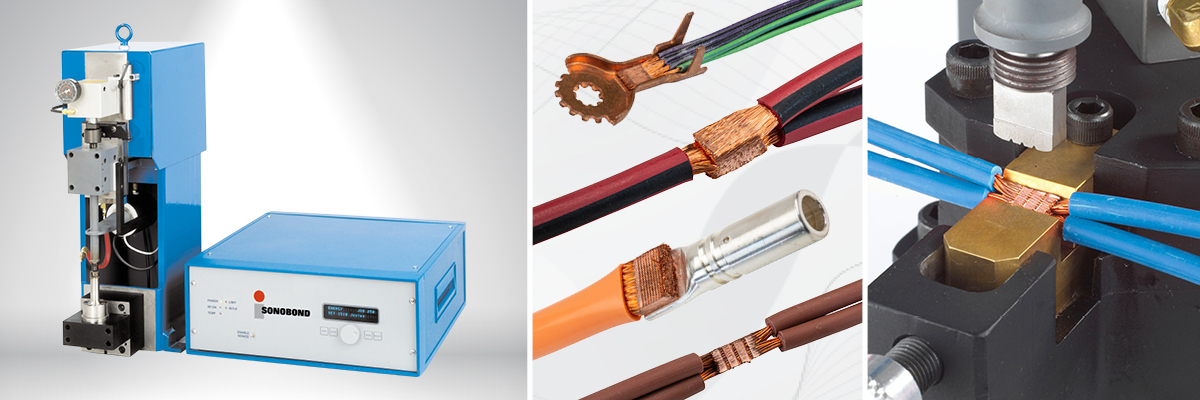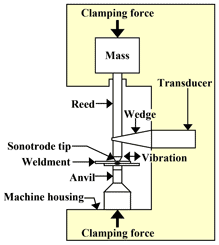Metal Welders

A Wide Variety of Important Applications
Sonobond’s ultrasonic metal welders are used to weld stranded wire-to-wire and wire-to-terminal for applications such as electrical wire harnesses and bus bars.
They are used to weld the terminals of lithium-ion batteries, foil-wound capacitors, thin aluminum or copper foil, and electrical contacts. They play an important part in the manufacture of fuses/circuit breakers, ignition modules, starter motors, and photovoltaic panels. And Sonobond’s ultrasonic metal welders are also frequently used to close HVAC tubing, replacing crimp and solder methods.
Over 60 Years of Innovation and Leadership
Sonobond Ultrasonics (then known as Aeroprojects) invented ultrasonic metal welding in 1960. The company received the first patent ever issued for this technology, awarded for their Wedge-Reed Bonding System. Since then, Sonobond has been the worldwide leader in the development of ultrasonic welders for non-ferrous metals.
Sonobond ultrasonic metal welders create strong, precise, solid-state metallurgical bonds without heat, current, or consumables. The company’s Wedge-Reed System accomplishes this by introducing high-frequency vibration while the weldment is under moderately high clamping force. Non-ferrous similar and dissimilar metals can be welded with repeated accuracy, and tinned or oxidized metals can be joined in just one pulse and without pre-cleaning – no other ultrasonic metal welder has this unique capability.
Click here to download Sonobond’s free Ultrasonic Metal Welding Primer. It contains an in-depth explanation of the process and principles involved in ultrasonic metal welding, as well as helpful information about equipment and applications.
Sonobond’s Unique “Wedge-Reed” Bonding System
Sonobond’s spot welders use the Wedge-Reed System for superior welds. Sonobond’s metal spot welders have an important advantage over other types of ultrasonic metal welding equipment because they use the unique, patented “Wedge-Reed” bonding system.

This system maximizes metal welding effectiveness by combining low vibratory amplitude with high vibratory force. Dependability is assured by utilizing shear mode vibration that is parallel to the welding surface. The line of force is positioned directly over the welding surface, eliminating bending stress caused by other ultrasonic metal welders, achieving more durable welds than crimp or solder methods, and eliminating metallurgical changes such as porosity and intermetallics that can be found in fusion welds.
This bonding method permits the joining of thin-to-thin or thin-to-thick materials, including dissimilar metal joints. It produces joints with good thermal and electrical conductivity, while welding through most oxides and tinned metals. No special cleaning process is required.
Contact Sonobond for a free Comparison of Ultrasonic Metal Welding Systems. This technical data sheet contains in-depth explanations of the two systems used for ultrasonic metal welding—Sonobond’s patented Wedge-Reed System and our competitors’ lateral drive system. A comparison of both systems’ design and operation; their capabilities, amplitude and force differences; and the importance of matching system and load impedance are included.
A Wide Variety of Important Applications
Sonobond’s ultrasonic metal welders are used to weld stranded wire-to-wire and wire-to-terminal for applications such as electrical wire harnesses and bus bars.
They are used to weld the terminals of lithium-ion batteries, foil-wound capacitors, thin aluminum or copper foil, and electrical contacts. They play an important part in the manufacture of fuses/circuit breakers, ignition modules, starter motors, and photovoltaic panels. And Sonobond’s ultrasonic metal welders are also frequently used to close HVAC tubing, replacing crimp and solder methods.
